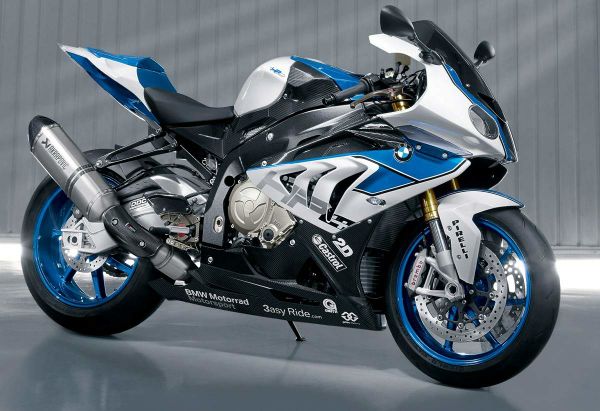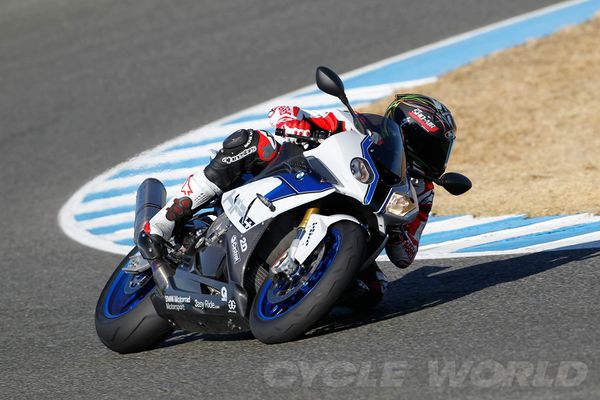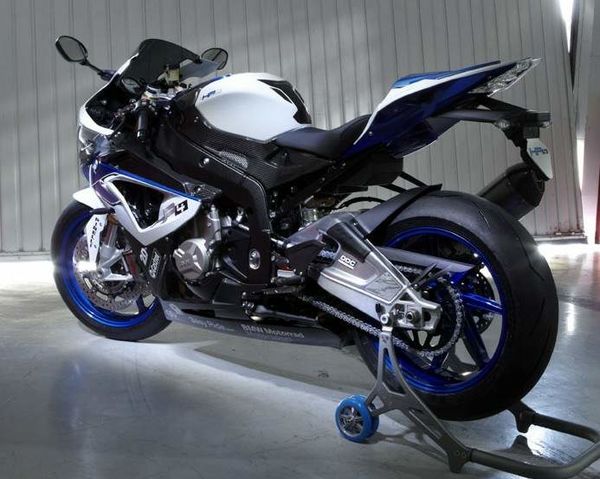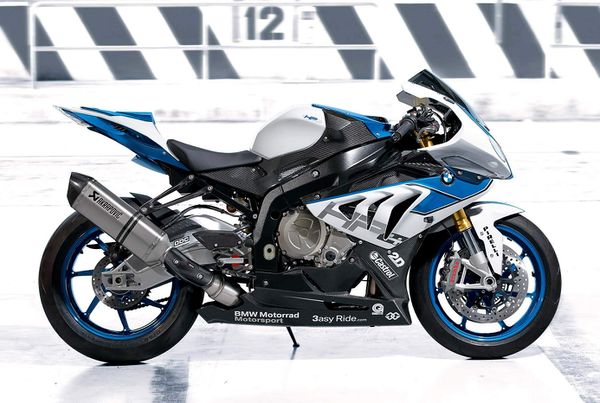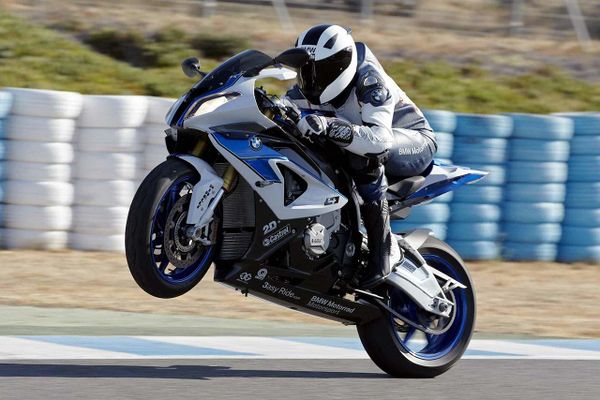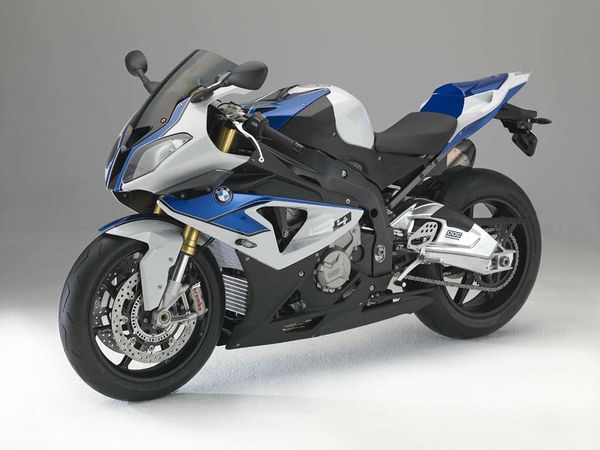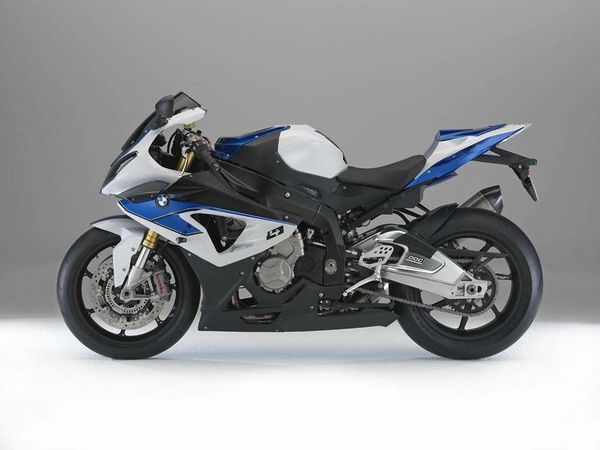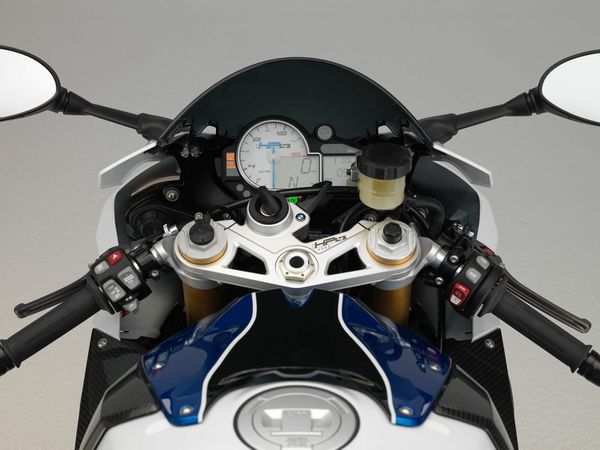BMW HP4
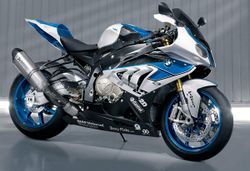 |
|
| BMW HP4 Race | |
| Manufacturer | |
|---|---|
| Also called | HP4 Carbon, HP4 Race Prototype, HP4 |
| Production | 2013 |
| Engine | Four stroke, transverse four cylinder, DOHC, 4 valves per cylinder |
| Compression ratio | 13:1 |
| Air Filter | K&N `15-18[1] |
| Spark Plug | NGK LMAR9D-J `13-14[2] |
| Battery | 12 V / 7 Ah, maintenance-free |
| Transmission | 6 Speed |
| Final Drive | Chain: 525 `13-14[2] |
| Frame | Bridge-type aluminum frame, load-bearing engine |
| Suspension | Front: USD fork with DEC, fixed fork tube diameter 46 mm damping electronically adjustable, spring preload adjustable, Rear: Aluminum double-sided swing arm with DDC central spring strut, compression and rebound stage electronically adjustable, spring preload hydraulicaily adjustable |
| Brakes | Front: 2 x ∅320mm discs radial monoblock, 4-piston fixed caliper Rear: Single ∅220mm disc, 1 piston floating caliper |
| Front Tire | 120/70 ZR17 |
| Rear Tire | 200/55 ZR17 |
| Wheelbase | 1422 mm / 56 in. |
| Seat Height | 820 mm / 33.3 in. |
| Weight | 169 kg / 373 lbs. (dry), 199 kg / 439 lbs (wet) |
| Fuel Capacity | 17.5 L / US 4.6 gal. |
| Manuals | Service Manual |
Engine[edit | edit source]
The engine was a Liquid cooled cooled Four stroke, transverse four cylinder, DOHC, 4 valves per cylinder. The engine featured a 13:1 compression ratio.
Drive[edit | edit source]
Power was moderated via the Multiple disc antihopping clutch in oil bath, mechanically operated.
Chassis[edit | edit source]
It came with a 120/70 ZR17 front tire and a 200/55 ZR17 rear tire. Stopping was achieved via 2 x ∅320mm discs radial monoblock, 4-piston fixed caliper in the front and a Single ∅220mm disc, 1 piston floating caliper in the rear. The front suspension was a USD fork with DEC, fixed fork tube diameter 46 mm damping electronically adjustable, spring preload adjustable, while the rear was equipped with a Aluminum double-sided swing arm with DDC central spring strut, compression and rebound stage electronically adjustable, spring preload hydraulicaily adjustable. The HP4 was fitted with a 17.5 L / US 4.6 gal. fuel tank. The bike weighed just 169 kg / 373 lbs.. The wheelbase was 1422 mm / 56 in. long.
Photos[edit | edit source]
Overview[edit | edit source]
BMW HP 4
With the BMW HP4, BMW Motorrad presents the lightest
4-cylinder supersports bike in the 1000cc class to date. Based on the BMW S 1000
RR, the new HP4 has an output of 193 hp (142kW) and has a dry weight of 373 lbs
(169 kg) including Race ABS . Race ready with a 90% full fuel tank just 439 lbs
(199 kg).
The new BMW HP4 sees its world premiere in 2012 and is a continuation of BMW Motorrad's HP model series founded in 2005. After the boxer models HP2 Enduro, HP2 Megamoto and HP2 Sport, the BMW HP4 is the first 4-cylinder motorcycle in the HP family.
The HP label stands for high performance, and the HP4 once again embodies outstanding handling, power and riding dynamics. But it also reflects the use of extremely high-quality materials and intelligent technology, carefully conceived down to the last detail.
BMW High Performance motorcycles are truly outstanding: exclusive and authentic, they will always remain relatively rare. This applies equally to the new BMW HP4. Each motorcycle is issued with its own HP4 serial number which is engraved indelibly in the upper fork bridge.
The new production HP4 is immediately ready for use on the race track, requiring no elaborate modifications. However, at the same time it offers great potential for dynamic road riding.
The new HP4 - exclusive performance based on the S 1000 RR.
Since its international press presentation in autumn 2009, the S 1000 RR has
attained many successes - and not just in motorcycle magazine comparative tests.
This is clear evidence of the qualities and the consistency of the supersports
concept. Equipped with Race ABS and Dynamic Traction Control (DTC), the S 1000
RR set a new benchmark in this hotly contested and technologically sophisticated
segment. But even the S 1000 RR left some room for improvement.
Technical innovations for enhanced sports performance.
The HP4 provides the homologation basis for the use of BMW motorcycles in motorcycle racing, especially in the superbike and superstock category. The new model features numerous technological innovations which highlight its orientation towards racing and the race track. The standard passenger seat cover ensures the monoposto (solo rider) look so characteristic of the race track. But for riders who would like to travel with a passenger, BMW Motorrad also offers a passenger package as a factory production option. In addition to the passenger seat, this includes the passenger footrest system.
Dynamic Damping Control DDC - a world first in production motorcycle construction.
The new HP4 reflects its status as a high-performance motorcycle in terms of its suspension system with a world first for production motorcycles: it is standard equipped with Dynamic Damping Control (DDC). This system allows dynamic damping adaptation of the upside-down fork and spring strut to the specific riding conditions on the road. The damping adapts to the current riding maneuver or road surface by means of sensors and electrically controlled regulation valves. The HP4 offers optimum damping in every riding condition to provide maximum traction and safety.
High Performance brake system and Race ABS with IDM
setting for maximum brake performance.
With the introduction of Race ABS in the S 1000 RR, BMW Motorrad underscored its pioneering role in the area of ABS. For the first time ever, an antilock brake system was consistently tailored to sport riding.
With the new race-oriented HP4, BMW Motorrad now takes the next step. Designed specifically for race track and dynamic road riding, the new bike not only has Brembo monoblock brake calipers and 9x floating brake discs at the front but also a further developed and refined Race ABS.
As before, this ABS has four different modes for wet surfaces ("Rain"), roads ("Sport"), race track with supersports tires ("Race") and race track with slicks ("Slick"). Racing experience gained from the IDM (International German Motorcycle Championship) has been fed directly into the Race ABS equipped HP4. In "Slick" mode, the so-called IDM setting with refined regulation impulses now gives the skilled rider the option of maximum possible deceleration.
New 200/55 ZR 17 tires on the rear wheel and finely adjustable Dynamic Traction Control in "Slick" mode.
The HP4 uses a rear tire in the new format 200/55 ZR 17. The Dynamic Traction Control (DTC) already used in the S 1000 RR has been optimized for supersports use in the HP4: now the effect of traction control can be adapted in "Slick" mode to changing road conditions and the rider's individual preference while riding.
Launch Control for perfect starts and shift
assistant for optimum gearshifts.
The HP4 is the first BMW motorcycle to have a Launch Control function which provides active support for the rider in "Slick" mode to achieve maximum acceleration from standing - for example on race starts. Launch Control limits engine torque so as to provide the maximum torque transferable to the rear wheel. This means the rider has to focus less on the throttle because he is controlling acceleration solely using the clutch. In addition, when Launch Control is activated, engine torque is reduced as soon as the system detects front wheel lift. This prevents unwanted wheelies when accelerating.
The HP4 allows the rider to make instant gearshifts with virtually no interruption of traction force by means of the shift assistant, equipped as standard. This helps gain valuable fractions of a second on the race track, too.
Weight reduction - Forged wheels, lighter sprocket carrier, titanium exhaust system and lighter battery.
New 7-spoke wheels in forged light alloy and a new, lighter sprocket carrier give the HP4 a weight reduction of 5.3 lbs (2.4 kg) as compared to the S 1000 RR. The exhaust system is made entirely of titanium and saves as much as 9.9 lbs (4.5 kg) as compared to the S 1000 RR, thereby enhancing the HP4's handling qualities. The new exhaust system has a resonance pipe between cylinders two and three, a controlled acoustic valve and a closed-loop catalytic converter. It has been possible to improve the torque curve thanks to the new exhaust system, with the engine application adapted accordingly.
Enhanced engine set-up and increased torque in the mid-range.
The new HP4 is equipped with the water-cooled 4-cylinder in-line engine of the S 1000 RR with a peak output of 193 hp (142 kW) at 13,000 rpm and a maximum engine speed of 14,200 rpm. As in the S 1000 RR, its maximum torque of 83 lb-ft (112 Nm) is achieved at 9,750 rpm. The torque has been perceptibly increased in the 6,000 rpm to 9,750 rpm range. In "Rain" mode there is now a smoother output and torque curve available between 2,500 rpm and 8,000 rpm.
Unlike the S 1000 RR, the 4-cylinder in-line engine in the HP4 provides the full output of 193 hp (142 kW) at 13,000 rpm in all modes - "Rain", "Sport", "Race" and "Slick" - with an identical throttle curve making it perfect for use on the race track.
Supersports - accommodation for sporty riders.
The HP4 has numerous special features to meet the needs of sports and racing riders. For example, the instrument cluster not only has a newly designed dial face with HP4 inscription but also provides an extended range of information and functions. The information display now shows the DDC set-up menus as well as the figures for DTC adjustment and Launch Control activation.
Styling of the new HP4 shows supersports aspirations for the race track and for dynamic public road riding. In addition to the monoposto (solo rider) look there is a dual-section engine spoiler - elongated as compared to the S 1000 RR which highlights the increased dynamic performance of the HP4. The laser-engraved HP4 logo with serial number on the upper fork bridge underscores the bike's exclusive character. An elaborate multiple color paint finish in Racing Blue Metallic/Light White creates an appropriate racing-oriented appearance.
HP4 with Competition Package - Exclusivity
For anyone who wants even more than the functional sophistication and extreme
riding dynamics of the HP4, the HP4 with Competition Package is an especially
exclusive version of the motorcycle. Refined HP carbon parts including a long,
closed HP engine spoiler in carbon, an adjustable HP rider footrest system,
folding HP brake and clutch levers, wheels finished in Racing Blue Metallic and
a factory sponsor sticker kit provide additional enhancement of the new HP4.
BMW HP4 Key Features
Pure performance When light weight, massive power and razor-sharp handling are combined, the result is known as HP - High Performance. The new HP4 is BMW Motorrad's first 4-cylinder model to wear the HP badge. Based on the S 1000 RR, a purebred factory motorcycle has been developed - made from the very best materials and molded into unparalleled design.
Pure power: The lightest 4-cylinder engine in the segment provides uncompromising power with an output of 193 bhp and a maximum torque of 83 lb-ft. The new exhaust silencer provides a higher level of torque in the mid-range, so there is power available where it's needed most to deliver stunning lap times.
Pure intelligence With the world's first ever dynamic suspension system DDC (Dynamic Damping Control), the HP4 is the most advanced production sporting motorcycle ever built. DDC automatically adapts the suspension damping to the situation at hand. Various modes are available to choose from: Rain and Sport for public roads, Race and Slick for the race track. The further enhanced Dynamic Traction Control on the HP4 supplements this perfectly. It can be finely adjusted in Slick mode to dial in the perfect balance between system support and rider control. The result is transparent feedback, maximum traction and optimum acceleration.
Pure exclusivity
The new HP4 comes into its own with its refined paint finish in white and Racing
blue. The HP4 will only be available in limited numbers through 2014.
o Fork bridge with engraved number and HP4 logo.
o Lightest 1000 supersports bike with four cylinders: 439 lbs (199 kg) (90% DIN unladen weight).
o Innovative suspension with Dynamic Damping Control (DDC).
o Race ABS with IDM setting.
o Dynamic Traction Control (DTC) with fine tune adjustment in "Slick" mode.
o Launch Control.
o Adapted wheelie detection.
o New rear wheel tires, 200/55 ZR 17.
o Shift assistant as standard equipment.
o Light titanium exhaust system with controlled acoustic valve and resonance
pipe.
o Forged light alloy wheels, anodized in black.
o Radial monoblock brake calipers by Brembo with special brake pads.
o 9x floating brake discs at front.
o Extended, dual-section engine spoiler.
o Seat in monoposto look with passenger seat cover.
o Lighter 7 Ah battery.
o Performance-oriented engine set-up.
o Increased torque in the medium engine speed range.
HP4 with Competition Package:
o Long, closed engine spoiler made of carbon.
o Sponsor sticker kit included.
o Wheels in Racing Blue Metallic.
o HP Carbon badge carrier.
o HP Carbon tank cover.
o HP brake lever, hinged.
o HP clutch lever, hinged.
o HP rider footrest system, adjustable.
BMW HP4 Features and Benefits
Technology and design.
Dynamic Damping Control (DDC) - dynamic damping adjustment to match road and track conditions.
BMW Motorrad has stood for leading expertise and groundbreaking innovations for 90 years, and this applies equally to the area of suspension. One example among many is Electronic Suspension Adjustment (ESA) introduced in 2004, a system for the electronic adjustment of damping and spring tension. Five years later this system was produced in the BMW GS models under the name of Enduro ESA, allowing the suspension to be raised for off- road use. In 2008 BMW Motorrad presented today's ESA II, permitting electronic adjustment of the spring rate for the first time, allowing adaptation to varying load conditions.
Dynamic Damping Control (DDC), produced in the HP4 as a world premiere in a road-legal production motorcycle, goes one step further. This system involves dynamic adaptation of compression and rebound stage damping to adjust to given riding conditions, for example, fast changes of direction in chicanes or uneven stretches of road. The semi-active suspension system reacts automatically to maneuvers such as braking, accelerating and cornering on various road surfaces and sets the correct level of damping by use of electrically actuated damping valves.
The basic settings of Dynamic Damping Control (DDC) are linked to the modes "Rain", "Sport", "Race" and "Slick", which can be conveniently selected by the rider at the press of a button. The set-up menu in the instrument cluster allows the damping to be adjusted more closely to the rider's preferences. Similar to a mechanical adjustment, it is possible to apply a softer (-7) or a tighter (+7) set-up. The adjustment of the spring preload is carried out by hand using a 17 mm wrench.
In the "Rain" and "Sport" mode, the DDC set-up focus is on a full, comfortable damping as preferred when riding on public roads or on poor to smooth roads. In the "Race" and "Slick" modes, however, the DDC set-up is geared more towards performance, supporting a very sporty riding style on the race track in particular. Damper set-up is tight and gives the rider clear feedback at all times.
The great benefit of DDC lies in the fact that it is dynamic, allowing damping set-up to be adjusted while riding. During development of the DDC, BMW Motorrad also benefited from synergies with BMW automobiles, where this technology has been used in production for some time. The challenge was in adapting it to motorcycle physics and integrating the appropriate control systems.
Damping adjustment within the millisecond range is done by means of an electrically controlled valve with a piston ring movement, adjusting the flow of the damper oil. This means that the HP4 provides the best setting for damper rebound and compression stage in each riding condition. Compromises in terms of suspension set-up are a thing of the past. DDC provides maximum traction for optimum deployment of engine power during acceleration.
When the ignition is switched on and before moving, the system check is activated first, initiating the flow of information from the engine control system, sensor box and spring travel sensor to the Dynamic Damping Control DDC. The DDC control unit processes a large amount of information relevant to driving dynamics such as spring travel, road speed and throttle valve position. The sensor box also supplies information to DTC on the banking angle of the motorcycle and other parameters.
The two fork legs of the DDC upside-down fork are identical in structure - the
difference lies in the interior of the fixed fork tube and slider tube. The
setting mechanism for the 15 mm (on the S 1000 RR is 20 mm) variable spring
preload, is in the right-hand fork leg. The valve responsible for increasing
pressure of damping power is housed in the damper cartridge of the left-hand
fork leg, together with its electrical connection. The balancing chamber in the
lower section of the left-hand fork leg is subjected to increased gas pressure
and absorbs the displaced volume of oil from the damper piston rod in the closed
cartridge.
As standard, the telescopic fork damping is controlled on an integrated basis and not separately for the rebound and compression stage. However, the wiring harness of the HP4 is equipped with a connection for a linear spring travel sensor at the fork. The control unit detects when the sensor is connected and extends the menu in the instrument cluster to include a separate rebound and compression stage setting. This sensor is available as an aftermarket accessory.
The new DDC spring strut is bolted onto the frame by a light alloy insert, the so-called sliding block. The motorcycle is factory supplied with a 0 mm insert. The two included inserts (1.5 and 3 mm) allow the rear of the motorcycle to be raised and the suspension geometry to be quickly adapted to prevailing road conditions and the rider's individual preferences. When using a different sliding block, the rear spring travel sensor has to be calibrated accordingly using the set-up menu. At the front the adjustment is made in the usual manner by means of the fork bridge clamp.
Race ABS with IDM setting - for top brake performance on the race track.
BMW Motorrad was the first motorcycle manufacturer in the world to equip its motorcycles with the antilock system ABS over 20 years ago, setting a milestone in active motorcycling safety at the time. Today all BMW motorcycles throughout the world are equipped with ABS as standard. With the introduction of the S 1000 RR in 2009, BMW Motorrad added another milestone in brake technology when it launched Race ABS, specially tailored to the supersports needs of the S 1000 RR.
BMW Motorrad now takes another step forward in the HP4. The system has been further refined and in particular adapted for use on the race track. As before, it has four different modes for wet surface ("Rain"), road ("Sport"), race track with supersports tires ("Race") and race track with slicks ("Slick").
In the modes "Rain", "Sport" and "Race", the Race ABS operates on a partially integral basis, in other words, the rear wheel is automatically braked when the front wheel brake is activated. This ensures that the motorcycle remains considerably more stable while braking achieving very short braking distances.
In "Slick" mode, the Race ABS setting in the HP4 is now at maximum deceleration, giving the rider transparent feedback on traction at all times. The new IDM setting - developed during the German Superbike Championship - allows maximum deceleration at the grip limit of the tires. In this mode, both the rear wheel lift detection and ABS function are deactivated for the rear wheel, allowing skilled riders to control the HP4 using the rear wheel brake and perform brake drifts.
New rear wheel tire, size 200/55 ZR 17.
Finely tunable Dynamic Traction Control in "Slick" mode.
The HP4 now features a rear wheel in the new 200/55 ZR 17 format. Dynamic
Traction Control (DTC) has been optimized for supersports use in the HP4. While
riding in "Slick" mode, the DTC can be adjusted to changing grip levels by using
the switch "Slick +/- DTC" on the left-hand control panel on the handlebars.
This now offers the rider more flexibility to environmental conditions such as
air and asphalt temperature and changes in tire grip and road surfaces.
The adjustment range is in seven increments via 0 to +7. Level 0 corresponds to the "Slick" mode setting familiar from the S 1000 RR, while - 7 represents a significant reduction in control intervention. This allows much more powerful slides to be performed. By contrast, the DTC system intervenes much more perceptibly at +7.
Launch Control - for optimum acceleration and starts in "Slick" mode as well as wheelie detection. A high level of skill is required to effectively turn power into forward thrust when accelerating from a standing position - as when starting a race for example - especially in the case of a high-performance supersports bike. For this reason, the HP4 is the first BMW motorcycle to offer a Launch Control function which provides active start traction support for the rider in "Slick" mode.
In order to ensure full acceleration from a standing position, Launch Control limits engine torque so as to provide the maximum torque transferable to the rear wheel. This means the rider has to focus much less on the throttle because he is controlling acceleration solely using the clutch. He can leave the throttle virtually wide open.
During the actual starting process engine speed is limited to 8,000 rpm; when
the 37.28 mph (60 km/h) mark is passed this limit no longer applies. If the
rider shifts into second gear, the engine torque is automatically corrected to
allow for the change in gear ratio, once again transferring maximum torque to
the rear wheel.
Launch Control is deactivated when third gear is engaged, when the motorcycle reaches a banking angle of over 30 degrees or when the rider switches into a different DTC mode. The function is also deactivated if the ignition is switched off or if the engine stalls.
The HP4 also supports the rider when Launch Control is activated by means of the adapted wheelie detection function, which reduces engine torque as soon as any lift is detected in the front wheel. If Launch Control is not activated, wheelies are permitted in "Race" mode at a banking angle of under 25 degrees and in "Slick" mode at less than 30 degrees.
Shift assistant for upshifting with virtually no interruption of traction power.
The shift assistant is a standard feature of the HP4. It enables the rider clutchless upshifting under full throttle virtually without any interruption of traction force. Here the ignition and fuel feed are interrupted for a fraction of a second. The aim is to save valuable lap time when accelerating.
Light forged wheels and an even higher performance brake system.
The new HP4 features high-quality forged light alloy wheels to reduce rotating
masses, offering optimized acceleration, deceleration and handling. The new
7-spoke wheels weigh 5.3 lbs (2.4 kg) less than the wheels of the S 1000 RR. In
the HP4 the wheels are finished in anodized black, while the HP4 with
Competition Package has wheels finished in Racing Blue. Further weight reduction
is achieved using a new, lighter sprocket carrier and a smaller and lighter
battery with a capacity of 7 ampere-hours.
The front brake system has 9x floating brake discs with a diameter of 12.6 Inches (320 millimeters) and radially arranged Brembo monoblock brake calipers. Brake pads developed especially for the HP4 produce improved brake performance, excellent stability on the race track and outstanding handling.
Performance oriented engine with improved torque range.
The new HP4 is equipped with the water-cooled 4-cylinder in-line engine of the S
1000 RR with a peak output of 193 bhp (142 kW) at 13,000 rpm and a maximum
engine speed of 14,200 rpm. Its maximum torque of 83 lb-ft (112 Nm) is achieved
at 9,750 rpm.
The 4-cylinder in-line engine in the HP4 now provides full output in all modes "Rain", "Sport", "Race" and "Slick" with an identical throttle curve and same throttle response - preferred when riding on the race track.
For more powerful acceleration out of a curve, the torque has been increased in the 6,000 rpm to 9,750 rpm range. For "Rain" mode, output and torque have been smoothed out in the 2,500 to 8,000 rpm range. This also adapts the motorcycle's characteristics to conditions in which there is reduced grip.
Light titanium exhaust system with controlled acoustic valve and resonance pipe.
The new exhaust system, made entirely of titanium, reduces the weight of the HP4 by 9.9 lbs (4.5 kg) as compared to the S 1000 RR. The new exhaust system has an resonance pipe between cylinders two and three, a controlled acoustic valve and a closed-loop catalytic converter. The torque curve has been improved thanks to the new exhaust system.
Instrument cluster - Newly designed dial face and extended range of information.
The new HP4 has a newly designed dial face with HP4 inscription and also provides three new information items. The information display now shows the DDC set-up menus as well as the figures for DTC fine adjustment and Launch Control activation.
Supersports design with monoposto look and elongated engine spoiler.
The HP4 fully lives up to its dynamic aspirations in terms of visual appearance. The bike is equipped with a passenger seat cover in keeping with its preferred solo use for sport riding purposes. However, a passenger package (passenger seat including passenger footrests) is available as a factory option for riding with a passenger. There is also a dual-section engine spoiler - elongated as compared to the RR, which emphasizes the dynamic qualities of the HP4. The exclusivity of the HP4 is identified by an HP4 logo with serial number applied by laser engraving on the upper fork bridge. The serial numbering does not apply separately to HP4 and HP4 Competition Package but is continuous.
Paint finishes.
The new HP4's special color scheme reflects a profile more closely geared
towards the race track as well as very sporty riding on public roads. In
conjunction with the HP4 logo, an elaborate multiple color finish in Racing Blue
Metallic / Light White gives the new HP4 an aggressive, dynamic and high-quality
touch. The black-coated frame, the silver anodized swing arm and the black
anodized wheels also provide a fascinating technical contrast.
The HP4 with Competition Package goes one step further. Wheels finished in Racing Blue Metallic, numerous carbon parts such as the long engine spoiler and a included sticker kit enhance the HP4 with Competition Package to a greater extent, giving it an even more dynamic look.
In line with the premium quality of the BMW HP4, the painted parts are covered with an additional clear coat.
BMW HP4 Options
o Competition Package.
o Long closed engine spoiler made of carbon.
o Sponsor sticker kit.
o Wheels in Racing Blue Metallic.
o HP Carbon badge carrier.
o HP Carbon tank cover.
o HP brake lever, hinged.
o HP clutch lever, hinged.
o HP rider footrest system, adjustable.
o Passenger package.
o Passenger seat.
o Passenger footrest system.
o Heated grips.
o Anti-theft alarm system.
Special accessories.
o HP Carbon wheel cover, front.
o HP Carbon wheel cover, rear.
o HP Carbon badge carrier.
o HP Carbon tank cover.
o HP brake lever, hinged.
o HP clutch lever, hinged.
o HP rider footrest system, adjustable.
o HP passenger footrest system.
o HP Carbon chain guard.
o HP Carbon heel guard.
o HP Carbon slipstream deflectors.
o HP Carbon tail-hump cover.
o Rear softbag.
o Tankbag.
o Windshield, high.
o Windshield, high, tinted.
o Sport auxiliary stand.
o Battery charger.
o Anti-theft alarm system.
o Motorcycle cover (outdoor and indoor).
HP Race parts.
o HP Race data logger.
o HP Race Power Kit.
o HP Race Calibration Kit II (TBA).
o HP Race Cover Kit.
o HP Race gearshift-pattern reverser.
o HP Race brake pads.
o HP Race tire warmers (TBA).
o HP Race wiring harness (TBA).
o HP Race pit carpet (TBA).
o HP Race Engine Kit I-III (TBA).
o HP Race gearbox (TBA).
BMW Motorrad HP Race Support Packages featuring technical support for private and professional racing.
BMW Motorrad rider equipment.
o DoubleR collection.
o DoubleR suit.
o DoubleR boots.
o DoubleR gloves.
o Sport suit.
o Start suit.
o SportDry boots
BMW S1000RR vs BMW S1000RR HP4
By -
First rides & tests A few months ago I was lucky enough to ride the new BMW HP4 at its world launch at Jerez, southern Spain. With perfect track conditions and slick tires to play on, it was a dream. More impressive still was the HP4. BMW has taken its already class-leading S1000RR and made it even better: 9kg lighter, more agile, smoother and even easier to ride fast, with refined electronics, larger brakes, fatter rear tire, and beefier midrange. Then, of course, theres its party piece: semi-active suspension. I lapped within two seconds of my best time set on my S1000RR race bike the previous year in similar conditions not bad for a bike with lights and mirrors. Best of all, I never had to adjust the HP4s suspension to achieve those times it automatically gave me the optimum settings, so it handled as well as you could ever set-up a standard S1000RR. Thats a huge plus for most of us who dont know our damping from our preload, but not a massive advantage for those who do. Thats all well and good on a smooth racetrack, and once youve got your suspension set, thats more or less it anyway youre good to go. The real test of semi-active suspension was always going to be on the road, in ever-changing conditions. Can it cope with UK roads? So here we are on a late November day, 1500 miles away from Jerez. The day starts off freezing cold and wet, but the gods of speed have granted me a dry, sunny and mild window of opportunity before it gets dark, cold and damp once more. If it wasnt for my jaw being clenched with speed-induced concentration, it would be dragging on the floor the HP4 has shocked me to the core. With all its power, refinement, light weight and grip, experience tells me to expect a warp-speed ride, like any other superbike but the semi-active suspension gives me a riding sensation Ive never experienced before. Right now Im on a tried and tested stretch of B-road. It swoops up and down. It wriggles from side to side. Its bumpy and littered with broken Tarmac. The most frightening bike Ive ever ridden through here was an Aprilia RSV 1000R, which tank-slapped through just about most of it. Other superbikes are simply too fast along here they just want to take off. The best bikes on this road are small nakeds, 600s, or the GSX-R750 at a push in other words, bikes with more handling than engine. With its semi-active suspension, the HP4 seems to flatten the swoops and repair the broken Tarmac. It throws rose petals in its own path, for its Pirellis to glide softly over. Attack the same piece of road on the S1000RR and its just like any powerful superbike the faster you go, the more you feel like the tires are skating the surface, and the bars come alive in your hands. Youre riding with your fingertips, on the balls of your feet, with your eyes out on stalks. On the HP4 its the opposite. The faster you go, the more the tires dig in and the more stable it becomes. Bars stay solid in your hands and the HP4 gives you the confidence to push the front ever harder into corners and twist the throttle sooner coming out. Youre hitting the throttle stop in places where its feathered on the standard S1000RR.
Granted, the HP4s new traction control, anti-wheelie, monobloc Brembo brakes and lightweight wheels are all helping magnificently, but its the semi-active suspension doing most of the work here.
Best handling road bike The clever suspension makes the HP4 handle better than anything Ive ever ridden on the road. Its a bold claim given the quality of bikes out there, but it makes sense after all, who ever goes to the same lengths of setting up their suspension for the road as they do on track? Trying would be impossible anyway, because youd never get a setting to work in all conditions but thats what semi-active suspension does for you, constantly adjusting to give you just about the perfect set-up in any freeze-frame of time. In that respect, it must be the ideal bike for the Isle of Man TT. You cant actually feel the semi-active suspension doing its job, other than giving you this great handling, but there are clues its there. With the HP4s engine switched off, the suspensions default setting is maximum damping, so its like a block of wood to sit on. Once you turn the engine on, the suspension has zero damping, so you can bounce it up and down like a pogo stick. But once youre moving, the suspension adjusts itself, via motors inside the left fork leg and rear shock, reviewing data from the HP4s wheel-speed sensors, throttle position, gyros and rear shock movement by the millisecond. On the S1000RR, the front end gets lighter and the rear suspension squashes down as you go faster and thats what makes the steering go vague and results in the bars kicking in your hands over bumps when youre pushing hard. But on the HP4, support from the suspension increases as speed rises. Not only have you got all this lovely control, but the ride quality is plush and sumptuous, too like the very best racing suspension on a WSB or MotoGP bike on a track. The way the front wheel comes down from hovering wheelies over crests like its landed in double cream is almost spiritual. Theres no kicking from the bars over bumps, just a feeling of total grip and stability. Lets not forget the 2012 S1000RRs ride quality and suspension control is right up there with the best of any road bike. Its familiar, plush and keeps the BMW on the straight and narrow, but every now and then you hit a bump that crashes through you, or a series of the buggers forcing you to slow down. Conversely, on the HP4 Im actively seeking out the worst bits of Tarmac I can, but they melt away as soon as you run over them.
In each of the HP4s four riding modes from
Rain, through to Sport, Race and Slick the suspension moves from soft to hard.
In Rain mode, you start with a very soft ride and the suspension gets harder and
softer within that zone. You also get full power, a soft throttle response and
maximum intervention from the ABS and traction control.
But you can tie the HP4 in knots in Rain mode
if you ride it hard, the soft damping slows the steering. So when you want to go
faster, you simply switch to the next riding mode. As you move up through the
modes, the HP4 gives you more controlled suspension and sharper steering.
I ended up on Race mode, which gives excellent
suspension control at high speed and crisp steering, as well as more direct
throttle response, less anti-wheelie and enough ABS and traction control to give
you a safety margin over damp patches.
HP4 worse at low speed
The only place the HP4 is worse than the standard S1000RR is at low speed, through slow corners, where the suspension goes soft. As the rear end sinks, the HP4s steering feels a bit too lazy and chopper-like. But its a small price to pay for the advantages elsewhere. I didnt try the HP4s Slick mode, because it wasnt enabled on our test bike. Like all S1000RRs, you need to connect a plug under the seat to acknowledge the fact youre entering a world of no rear ABS, limited traction control and ultra-sharp throttle. You can adjust the traction control on the left bar in Slick mode, too.
Although the HP4 can cover ground quicker than
the S1000RR, ironically it feels more like a road bike and less like a racer.
For most of the time the HP4s semi-active
suspension is actually softer and more comfortable than the S1000RRs, because
it doesnt need to be any harder, and the steering is correspondingly lighter at
higher speeds.
The other main improvement over the S1000RR is
the HP4s new Brembo monobloc front brake calipers. Ultimate balls-to-the-floor,
hard braking performance between these and the S1000RRs two-piece Brembos is
about the same on track, but the monoblocs have a far stronger, more tactile
bite at road speeds, which is a welcome upgrade.
The HP4 is littered with lots of helpful little
nips and tucks compared to the S1000RR (see the At a glance panel above),
which make it slightly nicer and easier to ride fast on the road. But most of
these things, like the adjustable traction control and lighter wheels, exist to
help it lap faster around a track.
The only toy the HP4 doesnt seem to have, that I
can think of, is an auto-blipper for faster downchanges the opposite of a
quickshifter. Theyre amazing, and it cant be long before we see them on a road
bike. But it has got heated grips, a godsend in this weather.
Not content with beating off the competition with
its updated 2012 S1000RR, BMWs new HP4 kicks them while theyre down. And to
think the company only sold tourers and adventure bikes up until three years
ago
Verdict
Semi-active suspension really is the future. It
allows the best suspension setting for every second of your ride. It really
works.
For the road, the HP4 offers superior grip and
stability in comparison to the already brilliant S1000RR. Its impossible to set
your bike up perfectly for your favourite road there are too may variables.
And who could be bothered, anyway? Thats why the HP4 feels so good, giving you
the kind of soft here, hard there set-up youve never experienced before. Its
amazing.
It works equally well on track, too, without you
ever having to go through that whole trial-and-error process as you attempt to
set it up yourself.
But the irony is the HP4s semi-active suspension
makes it almost too capable for the road and its limits are too far away. I
was genuinely gutted when I packed the HP4 away at the end of the test. But in a
way, I was glad, too - its a bike thats far better used on the track.
And heres the paradox: the HP4 is too good for
the road, but if youve got the suspension knowhow, you could set up a standard
S1000RR equally well on track. A good aftermarket suspension system will be
better for racing, too, so the HP4 wont be the Second Coming for racers.
But none of that matters, because its a dream
bike, costing the same as a Ducati Panigale S. Very few of us will be lucky
enough to own one, but if youre one of the chosen few, rest assured theres
nothing faster road, or track.
Semi-active suspension will really shine when it
filters down to less powerful and cheaper bikes. Fit it to something light and
funky with no more than 100bhp and youd be able to hold it flat-out everywhere.
Now that is something to look forward to.
Source MCN
| Make Model | BMW HP 4 |
|---|---|
| Year | 2013 |
| Engine Type | Four stroke, transverse four cylinder, DOHC, 4 valves per cylinder |
| Displacement | 999 cc / 61 cu in. |
| Bore X Stroke | 80 x 49,7 mm |
| Intake / Exhaust Ø | ∅33.5 mm / ∅27.2 mm |
| Compression | 13:1 |
| Cooling System | Liquid cooled |
| Induction | Electronic fuel injection, digital motor electronics BMS-KP |
| Throttle Valve Diameter | ∅48 mm |
| Emission Control | Two regulated three-way catalytic converters, EU-3 |
| Starting | Electric |
| Alternator | Three-phase generator 350 W |
| Battery | 12 V / 7 Ah, maintenance-free |
| Max Power | 144 kW / 193 hp @ 13000 rpm |
| Max Torque | 112 Nm / 11.4 kgf-m / 82.6 lb-ft @ 9750 rpm |
| Clutch | Multiple disc antihopping clutch in oil bath, mechanically operated |
| Transmission | 6 Speed |
| Final Drive | Chain |
| Gear Ratio | 1st 2.647 / 2nd 2.091 /3rd 1.727 / 4th 1.500 / 5th 1.360 / 6th 1.261:1 |
| Transmission Ratio | 1:2.647 |
| Frame | Bridge-type aluminum frame, load-bearing engine |
| Front Suspension | USD fork with DEC, fixed fork tube diameter 46 mm damping electronically adjustable, spring preload adjustable, |
| Front Wheel Travel | 120 mm / 4.7 in. |
| Rear Suspension | Aluminum double-sided swing arm with DDC central spring strut, compression and rebound stage electronically adjustable, spring preload hydraulicaily adjustable |
| Rear Wheel Travel | 130 mm / 5.1 in. |
| Front Brakes | 2 x ∅320mm discs radial monoblock, 4-piston fixed caliper |
| Rear Brakes | Single ∅220mm disc, 1 piston floating caliper |
| Abs | BMW Motorrad Race ABS (partially integral, disengageable) |
| Front Wheel | 3.50x17 Forged light alloy, 7 spoke |
| Front Tire | 120/70 ZR17 |
| Rear Wheel | 6.00 x 17 Forged light alloy, 7 spoke |
| Rear Tire | 200/55 ZR17 |
| Rake | 24.0° |
| Trail | 99 mm / 3.9 in |
| Dimensions | Length: 2056 mm / 80.9 in. Width: 826 mm / 32.5 in. (incl. mirrors) Height: 1138 mm / 44.8 in. (excl. mirrors) |
| Wheelbase | 1422 mm / 56 in. |
| Seat Height | 820 mm / 33.3 in. |
| Dry Weight | 169 kg / 373 lbs. |
| Wet Weight | 199 kg / 439 lbs |
| Fuel Capacity | 17.5 L / US 4.6 gal. |
| Fuel Reserve | Approx. 4 L / 1.1 US gal |
Videos[edit | edit source]
References[edit | edit source]
- ↑ 2019 K&L Supply Co Catalog. K&L Supply Co. 2019.
- ↑ 2.0 2.1 2019 Western Power Sports Catalog. Western Power Sports. 2019.
